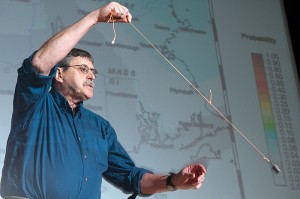We all know that you cannot dig a hole to China. This is true for lots of reasons. For starters, your shovel would melt as you began to reach the Earth’s molten core. Earth has a liquid outer core and solid inner core of iron and nickel.
Professor Vernon F. Cormier from the University of Connecticut has received $334,000 from the National Science Foundation to study the transition from liquid to solid in the Earth’s core using seismic wave measurements.
Cormier’s project will determine the structure of the Earth’s inner core in relation to the processes that affect its cooling, solidification and connection with the flowing liquid metals of the outer core.

Transitions in the elastic structure of the inner core have been favored as the mechanism responsible for Earth’s magnetic field. This occurs because lighter elements released by the solidifying solid inner core help stir the electrically conducting fluid metal of the outer core. Dynamo theory states that the magnetic field of a planet or star is created by the fluid-like movements of its core.
Lateral variations in the elastic structure of the inner core can be linked to variations in heat transport across the outer core boundary. This in turn impacts the behavior of Earth’s dynamo, including time changes in its magnetic field. By studying the structure and the phenomena that affect the Earth’s core, scientists will be able to better understand the evolution of planetary magnetic fields and their effects on atmospheres and life.
Cormier teaches physics at the University of Connecticut and is associated with the Center for Integrative Geosciences. He received his Ph.D. from Columbia University. His research focuses on solid Earth geophysics and the heterogeneous structure of the Earth. He studies and models the effects of seismic waves generated by descending slabs of tectonic plates, fault zones and chemical heterogeneity. A recent application of his research has included the seismic monitoring of underground nuclear tests conducted in complex Earth structure.
Cormier is currently writing a book on Earth’s core to be published by Elsevier Press.



